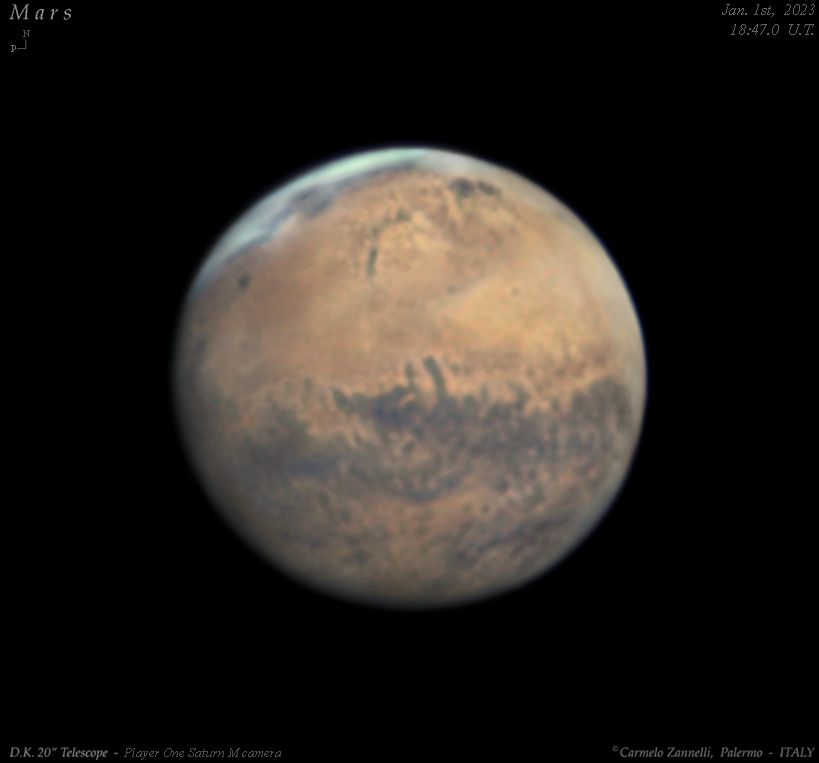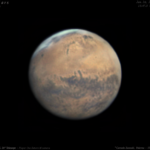Italiano (English below):
Eccovi un’immagine di Marte del 1° giorno del nuovo anno 2023, in buone condizioni di seeing.
In questi giorni Marte si allontana, lungo la sua orbita ellittica, molto velocemente dalla Terra per effetto del moto reciproco dei due pianeti, lungo le loro orbite intorno al Sole.
In evidenza, passato già in meridiano centrale, il “Mare Cimmerium” mentre il “Mare Tyrrhenum” già scorre avanzando verso il meridiano centrale. Il centro esatto dell’immagine è localizzato sull’antichissimo cratere Sharp, situato alla sinistra del più famoso cratere Gale, sede dell’atterraggio di “Curiosity”, uno dei rover marziani della NASA operativo da ben più di 10 anni sulla superficie del pianeta rosso.
In alto a destra dell’immagine, di colore più chiaro, la zona chiamata “Elysium Planitia”, che è per estensione la seconda regione vulcanica di Marte, dopo i “Monti Tharsis”. Essa include, da nord a sud, i vulcani “Hecates Tholus”, il più grande ed evidente “Elysium Mons”, l’ “Albor Tholus” oltre ai minori Cerberus Palus e Cerberus Fossae.
In questa immagine, “sembrerebbe” che la zona sia interessata dalle tipiche tempeste di sabbia marziane, ma servirebbero ulteriori immagini – di alta qualità, quindi riprese in condizioni di seeing eccellente – per confermarne o confutarne la presenza.
Una ampissima zona del polo nord marziano è ancora perennemente e vistosamente avvolta dalle nubi orografiche e dalle tempeste di nubi di polvere. Le tempeste di polvere si verificano su Marte – il più delle volte, ma non solo – durante la stagione estiva meridionale. In quel momento, il pianeta si trova più vicino al sole lungo l’orbita ellittica marziana e la luminosità aumenta le differenze di temperatura su Marte, che influenzano il movimento dell’atmosfera sul pianeta. Queste differenze di temperatura, permettono all’aria marziana di sollevare più facilmente le particelle di polvere sulla superficie.
Grazie, come sempre, per la Vs. gentile attenzione.
Dettagli Tecnici:
Telescopio Astrofaktorja DK20″ @ ~ F/28 – Televue 2″ PowerMate Barlow 2x – Baader RGB filters – Player One Saturn M camera – Seeing 6,5/10 in R band – sito: Palermo @ my personal Observatory
**********************************************************************************************
English:
Here is an image of Mars from the 1st of the new year 2023, in good seeing conditions.
In evidence, already past the central meridian, the “Mare Cimmerium” while the “Mare Tyrrhenum” already flows advancing towards the central meridian. The exact center of the image is located on the very ancient Sharp crater, located to the left of the more famous Gale crater, site of the landing of “Curiosity”, one of NASA’s Martian rovers operating for well over 10 years on the surface of the red planet till now.
At the top right of the image, lighter in color, the area called “Elysium Planitia”, which is by extension the second volcanic region of Mars, after the “Mounts Tharsis”. It includes, from north to south, the volcanoes “Hecates Tholus”, the largest and most evident “Elysium Mons”, the “Albor Tholus” as well as the smaller Cerberus Palus and Cerberus Fossae.
In this image, it would seem that the area is affected by the typical Martian sandstorms, but further images – high quality, therefore taken in excellent seeing conditions – would be needed to confirm or refute their presence.
A very large area of the Martian north pole is still perennially and conspicuously enveloped by orographic clouds and dust storms. Dust storms occur on Mars — most often, but not only — during the southern summer season. At that moment, the planet is closest to the sun along the elliptical Martian orbit and the brightness increases due to temperature differences on Mars, which influence the movement of the atmosphere on the planet. These temperature differences allow the Martian air to more easily lift dust particles to the surface.
Technical details:
Telescope Astrofaktorja DK20″ @ ~ F/28 – Televue 2″ PowerMate Barlow 2x – Baader RGB filters – Player One Saturn M camera – Seeing 6,5/10 in R band – site: Palermo @ my personal Observatory


